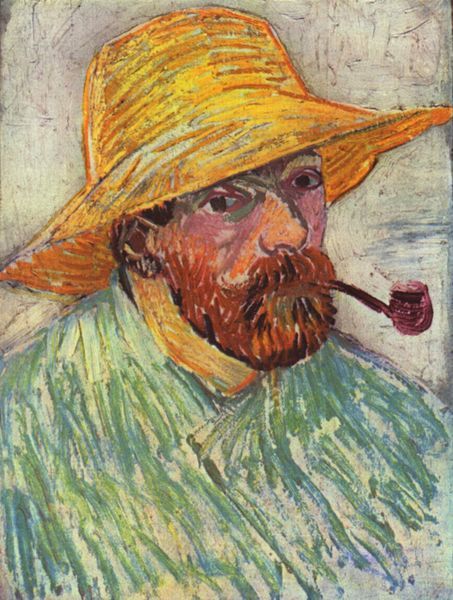
"I must say, we feel we are in the middle of a whirlwind that we didn't quite anticipate," Naifeh told AFP by telephone from Aiken, South Carolina where he and Smith live and work.
"We anticipated this would generate, not quite this level of furor -- but certainly some level of furor."
One of the most recognized artists of all time, Van Gogh suffered prolonged bouts of mental illness and depression. He famously sliced off part of his ear, and only sold one painting before his death in July 1890 at the age of 37.
"To us he's part of our visual DNA," said Naifeh, but in his time Van Gogh's fluid, vibrant style "looked garish and almost absurdly intensely colored" -- and it was inevitable that the artist was a troubled loner.
The Van Gogh Museum in Amsterdam, which collaborated with the authors, calls the shooting theory "interesting" and "spectacular," but adds it is too soon to jettison the long-held suicide version of events.
"The two authors have not found new facts; they have just interpreted them differently," said its curator Leo Jansen, a friend of the biographers who have endorsed "Van Gogh" as "the definitive biography for decades to come."
The idea of death by suicide was planted in popular imagination by the 1956 movie "Lust for Life," based on an Irving Stone novel, with Kirk Douglas as Van Gogh melodramatically shooting himself at his easel.
Wounded in the abdomen and bleeding profusely, Van Gogh supposedly dragged himself about one mile (two kilometers) back to the inn in Auvers-sur-Oise where he was staying, dying in his attic room.
"The sadness will last forever" were reputedly his last words.
But with the tenacity of homicide detectives, Naifeh and Smith uncovered nuggets of evidence that point -- inconclusively, they acknowledge -- in the direction of manslaughter.
Exhibit one: rumors heard by late art historian John Rewald in the 1930s from townspeople in Auvers old enough to remember that Van Gogh had been accidentally shot by young boys.
Exhibit two: an "incredibly self-incriminating interview" given in 1956 by a respectable Parisian banker, Rene Secretan, who recalled in detail how he and his brother Gaston delighted in tormenting Van Gogh as teenagers in Auvers.
"They were bullying him unbelievably," Naifeh told AFP.
"They put a snake in his paint box. They put salt in his coffee and red pepper on his brushes," which he habitually chewed while painting, and made out with girls by the river just to make him feel more miserable.
But as the target of bullying for much of his life, the authors say the red-headed Van Gogh -- who suffered from frontal lobe epilepsy -- was happy to put up with it as the price for having some companionship.
Exhibit three: a Van Gogh drawing of a boy in a cowboy hat. The authors suspect the lad is Rene Secretan, who in 1890 attended the Paris world fair where Buffalo Bill Cody's Wild West show from America was a big hit.
Duly infatuated with cowboys and guns, the young Secretans -- in adulthood Gaston became a cabaret and film star -- borrowed a pistol from innkeeper Arthur Ravoux to shoot birds and small animals.
Secretan said nothing, however, about shooting Van Gogh.
"It's what the legal profession calls an equivocal death -- a death where you really don't have enough facts to be certain," Naifeh said. "The most we would assume is accidental homicide."
Frustratingly, no police report seems to exist, even though two gendarmes questioned the wounded artist. "Believe me, we tried desperately to find a police report," Naifeh said. "Either none was filed or it was destroyed."
But Adeline Ravoux, the innkeeper's daughter who appears in one of his portraits, recounted in 1957 what Van Gogh told the police -- and the biographers say his words betray an attempt to protect the shooters.
"'Is it you who wanted to commit suicide?'," one police officer asked, according to Ravoux. "'Yes, I believe so'," the artist replied, before adding: "Do not accuse anyone. It is I who wanted to kill myself."
"We would argue he was lying," Naifeh said. "He was certainly capable of it. He lied frequently in his letters, always for a purpose -- and in this case we would argue for an incredibly generous purpose."
----------------------------------------------------------------------------------------
"We anticipated this would generate, not quite this level of furor -- but certainly some level of furor."
One of the most recognized artists of all time, Van Gogh suffered prolonged bouts of mental illness and depression. He famously sliced off part of his ear, and only sold one painting before his death in July 1890 at the age of 37.
"To us he's part of our visual DNA," said Naifeh, but in his time Van Gogh's fluid, vibrant style "looked garish and almost absurdly intensely colored" -- and it was inevitable that the artist was a troubled loner.
The Van Gogh Museum in Amsterdam, which collaborated with the authors, calls the shooting theory "interesting" and "spectacular," but adds it is too soon to jettison the long-held suicide version of events.
"The two authors have not found new facts; they have just interpreted them differently," said its curator Leo Jansen, a friend of the biographers who have endorsed "Van Gogh" as "the definitive biography for decades to come."
The idea of death by suicide was planted in popular imagination by the 1956 movie "Lust for Life," based on an Irving Stone novel, with Kirk Douglas as Van Gogh melodramatically shooting himself at his easel.
Wounded in the abdomen and bleeding profusely, Van Gogh supposedly dragged himself about one mile (two kilometers) back to the inn in Auvers-sur-Oise where he was staying, dying in his attic room.
"The sadness will last forever" were reputedly his last words.
But with the tenacity of homicide detectives, Naifeh and Smith uncovered nuggets of evidence that point -- inconclusively, they acknowledge -- in the direction of manslaughter.
Exhibit one: rumors heard by late art historian John Rewald in the 1930s from townspeople in Auvers old enough to remember that Van Gogh had been accidentally shot by young boys.
Exhibit two: an "incredibly self-incriminating interview" given in 1956 by a respectable Parisian banker, Rene Secretan, who recalled in detail how he and his brother Gaston delighted in tormenting Van Gogh as teenagers in Auvers.
"They were bullying him unbelievably," Naifeh told AFP.
"They put a snake in his paint box. They put salt in his coffee and red pepper on his brushes," which he habitually chewed while painting, and made out with girls by the river just to make him feel more miserable.
But as the target of bullying for much of his life, the authors say the red-headed Van Gogh -- who suffered from frontal lobe epilepsy -- was happy to put up with it as the price for having some companionship.
Exhibit three: a Van Gogh drawing of a boy in a cowboy hat. The authors suspect the lad is Rene Secretan, who in 1890 attended the Paris world fair where Buffalo Bill Cody's Wild West show from America was a big hit.
Duly infatuated with cowboys and guns, the young Secretans -- in adulthood Gaston became a cabaret and film star -- borrowed a pistol from innkeeper Arthur Ravoux to shoot birds and small animals.
Secretan said nothing, however, about shooting Van Gogh.
"It's what the legal profession calls an equivocal death -- a death where you really don't have enough facts to be certain," Naifeh said. "The most we would assume is accidental homicide."
Frustratingly, no police report seems to exist, even though two gendarmes questioned the wounded artist. "Believe me, we tried desperately to find a police report," Naifeh said. "Either none was filed or it was destroyed."
But Adeline Ravoux, the innkeeper's daughter who appears in one of his portraits, recounted in 1957 what Van Gogh told the police -- and the biographers say his words betray an attempt to protect the shooters.
"'Is it you who wanted to commit suicide?'," one police officer asked, according to Ravoux. "'Yes, I believe so'," the artist replied, before adding: "Do not accuse anyone. It is I who wanted to kill myself."
"We would argue he was lying," Naifeh said. "He was certainly capable of it. He lied frequently in his letters, always for a purpose -- and in this case we would argue for an incredibly generous purpose."
----------------------------------------------------------------------------------------









 Home
Home Politics
Politics









